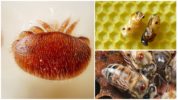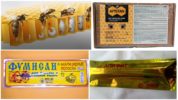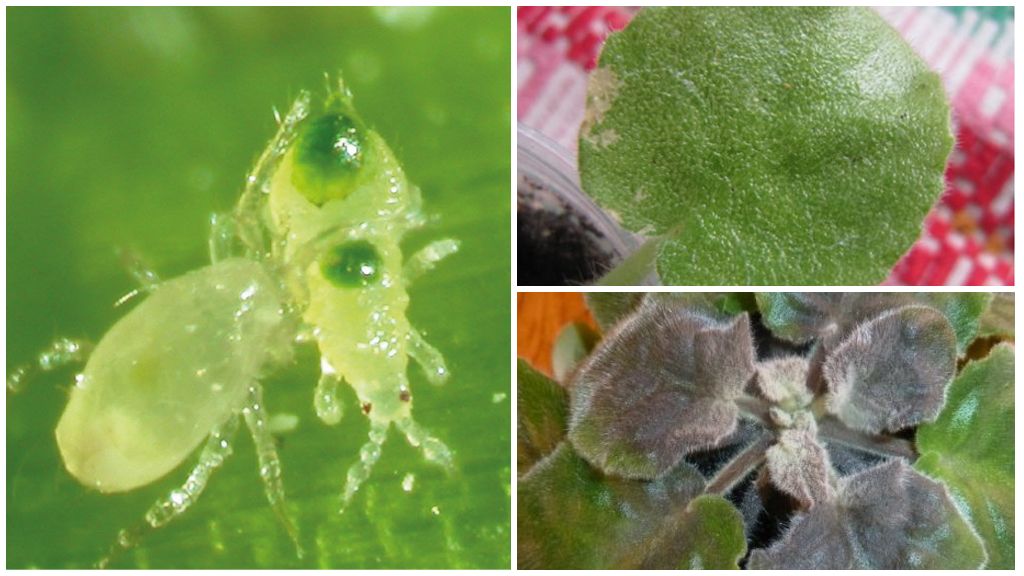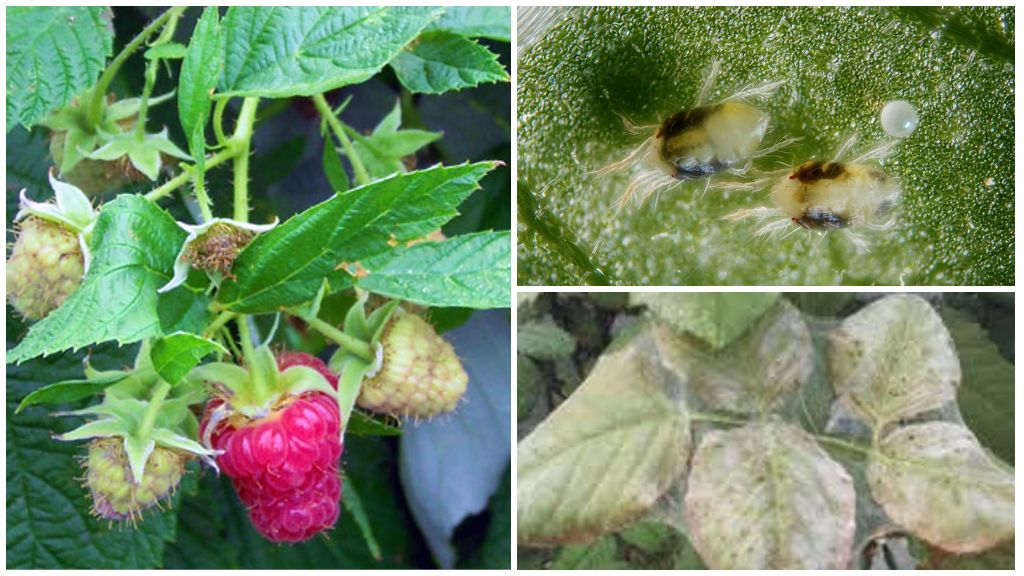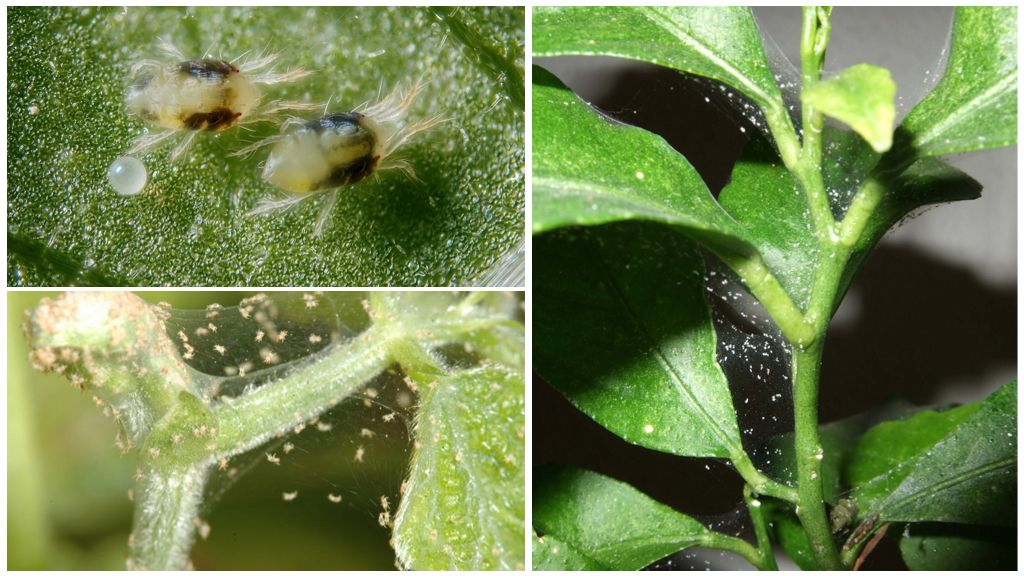- Mite Varroa
- Varroa mite control plates
- Anti-Tick Essential Oils
- Varroa tick repellent plants
The tick of varroa is a genus of arachnids that parasitize on bees. Parasitizing on bee colonies, ticks bring considerable economic damage to beekeepers. One of the varroa family species is considered responsible for the raging panzootia of varroatosis on the planet. The problem of reducing the population of bees on Earth has become acute in connection with the active use of insecticides in the fields. Ticks, which are very difficult to get rid of without damaging beneficial insects, contribute to the disappearance of bees.
General information
The genus Varroa contains 4 or 6 types of bee ticks:
- Destructor (Varroa destructor) - the most harmful species that parasitizes on Chinese wax (Apis cerana) and honey bees (Apis mellifera);
- Jacobson (Varroa jacobsoni) - parasitizes on a Chinese wax bee, he is assigned the blame for the panzootia of varroatosis;
- rinderera (Varroa rindereri) - parasitizes on the bee Kozhevnikova (Apis koschevnikovi);
- woody (Varroa underwoodi) - parasitizes on bees of Papua New Guinea.
Two more species are sometimes assigned to the genus Varroa, sometimes they are simply isolated into a separate genus Euvarroa, belonging to the family Varroidae.
Tick morphology
The photo of the bee tick on the host shows an arthropod rather large compared to the bee. The body of the tick is round, the legs are as if hidden under a shell. Body width 1.8 mm, length 1.1 mm. The color of the females is red-brown. In the photo, the bee tick looks like a shiny, hard brown plaque located on the larva or chest of the bee. In males, the body is soft, white. The life span of the female tick is 1 year, the male is no more than 3 weeks.
Lifestyle and breeding cycle
An increase in the number of ticks in the hive is closely related to the life cycle of the bee family. Female ticks wintering on bees in spring lay eggs in cells with a new bee brood. After bees seal the cells with brood, ticks go through the full development cycle, parasitizing on the larva. If there is only one parasite in the cell, then the bee comes out weakened. With a greater number of ticks on one insect, physical deformities are observed in bees.
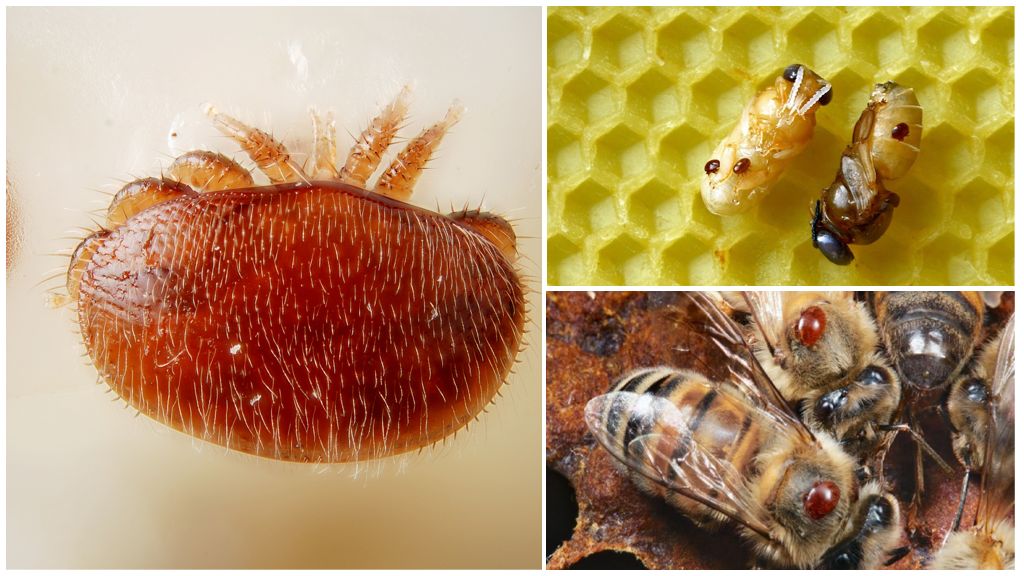
On a note!
Coming out of the cells, adult ticks move to bees and continue to feed on insect lymph. Biology tick such that a bee cannot rip it off of any surface. Yes, the bee does not feel the presence of a parasite on itself, it does not have a protection mechanism against ticks. Due to the lack of a defense mechanism, the varroatosis caused by ticks has already grown into panzootia.
Mite control of varroa
A small number of parasites does not cause much damage to the bee family. But ticks multiply very quickly and soon completely fill the hive. Signs of significant tick infection by the bee family:
- many ugly bees with underdeveloped wings;
- insects are lethargic;
- a large percentage of uterine death;
- drones are not able to inseminate uterus.
Treatment of bees for ticks is complicated by an almost complete ban on the use of chemicals. Poisons acting on ticks also harm insects.Even herbs that repel arachnids can also scare away bees. Therefore, herbal preparations are used carefully.
Chemicals
Of chemicals, the most safe strips from a tick with flumetrin or another similar acaricide. The trade names for the stripes may vary, but there is an acaricidal substance everywhere:
- Fumisan;
- Apiphyte;
- Apistan.
These three names are most popular among beekeepers, but there are many other similar products that differ from each other in price and number of plates in a pack. The number of records per family is indicated in the instructions.
Feedback
Beekeeping decided to do only last year. Everything was good right away, but this spring I noticed a tick on some bees. I was advised to use the strips as the least time-consuming way to fight. Brala Apistan. For each hive I put 2 strips. Now before wintering I checked the hives, maybe I didn’t notice, but the ticks were not visible.
Alena Tretyakova, Elektrostal

By means of plates it is possible to carry out processing in the summer and in the spring. The tool works according to the trap principle: according to the instructions, the plates are set so that the tick touches them creeping past. Acaricide paralyzes arthropod and it remains adhered to the plate.
On a note!
After 4 years, the tick develops resistance to acaricide and the tool must be changed.
As a medicine for bees, amitrase-based products are used. To destroy the parasite requires a solution of 12.5%. Preparations with amitraz give good indicators of family recovery and high survival of bees. But there is a heated debate among beekeepers about their harmlessness. Bees are treated from ticks in spring and autumn. In summer, funds with amitraz are not used.
Varrobraulin is an industrial plant-based product used throughout the season of active activity of bees. It is poured onto the framework of the hive at the rate of 3-5 g per family. Apply 3 times in 5-6 days. But most beekeepers prefer more gentle methods of control.
Important!
To restore the immunity of the bee family after using chemicals, Hitomilan is used - a new generation of immunostimulants.
Folk remedies
Before panzootia of varroatosis, non-chemical methods of control were successfully used in beekeeping. To scare away and destroy ticks use:
- essential oils;
- repellent herbs;
- natural acids;
- powdered sugar.
And a rather interesting, but very laborious and not widely used method: with a small number of ticks on bees and the presence of only a few families, arachnids are removed from insects manually. Jewelry work, requires a steady hand and a keen eye. Ticks are pressed very tightly against the body of the bee and it is easier to destroy the insect along with parasites. But the girl who tried this method felt sorry for her bees.
Essential oils
To protect bees from ticks, any essential oil is suitable. As in the case of other insects, it does not kill, but only scares off the parasites. Bees tolerate oils better, as they often collect nectar from essential oil plants.

15 g of purchased essential oil is mixed with 85 g of petroleum jelly and lubricated with 2 pieces of any material: polyethylene, old oilcloth. It is important that the fat does not spread beyond the substrate. One piece of oilcloth is placed under the frame with the smeared side up. The other is oil-framed down. The composition is updated every 5-6 days. 3-4 times are enough for the ticks to go away. But after the oilcloths are removed, the parasites will return sooner or later.
Coniferous powder
Needles of any tree species are dried and ground into powder. At the bottom of the hive lay a sheet of film with fat. Powdered needles sprinkle with hives along with insects. Parasites lose their ability to cling to the stubble of bees and fall down on fat. Powder consumption 50 g per family. Processing is carried out at least 3 times every 5-6 days.
Repellent plants
Instead of essential oils, ethereal plants are used:
- horseradish;
- thyme;
- garlic;
- orange peels;
- dill;
- other essential oil plants.
200 g of raw material is passed through a meat grinder, put between layers of gauze and placed in a hive on top of the frames. Top covered with a film. Change the drug with thyme every 2-5 days for 1.5 months. The family should be replaced by 2 generations of healthy bees.
Feedback
I tried using dry thyme. The tick wanted to sneeze at him.
Vadim Kotlyarevsky, Lugansk
How to use plants:
- Horseradish. Dried roots are used for smoking hives and insects. Quantity: 1 tbsp. spoon of roots for 3 families. Smoke cannon treatment is carried out every 6 days at least 3 times. It is best to carry out processing in the spring and in the fall. The best option is the processing of a swarm or barren layering.
- Ledum. The smoke of this plant is not processed by insects and hives, but by the framework that will be used to expand the nests. In the evening, the frames are placed in a plastic bag and smoke is released there. In the morning they are put in hives. The smell of Ledum smoke repels parasites.
- Celandine. For processing, use the infusion of celandine: 100 g of herb per 2 liters of boiling water. Insist 40 minutes. Strain the infusion and process the framework with it through a spray bottle. To eliminate varroatosis, family treatment is carried out several times.

On a note!
A week before pumping out honey, herbal preparations are no longer used.
Acids
Oxalic and formic acids have proven themselves well in the fight against varroatosis. Processing with oxalic acid occurs in the form of spraying with a 2% solution. Today, this method has remained in service with private owners who do not have special equipment. Industrial apiaries use a safer method for humans to spray oxalic acid vapor. Spraying is carried out in the spring.
In Germany, formic acid is preferred. In parallel, oxalic is used, feeding it to bees in the form of a mixture with sugar syrup.
Powdered sugar
Powdered sugar is sprayed in the hive on bees. Part of the powder wakes up at the bottom of the hive. Insects begin to cleanse themselves of the sweet powder, simultaneously cleansing ticks with powder. Parasites that fall to the bottom fall into the dust again. Since sugar powder absorbs water very well, mites soon stick to the powder and lose their ability to move. The disadvantage of this method is faster honey sugaring.
Physical methods
They mean methods of struggle without chemistry or folk remedies. This category includes 2 methods: heat treatment of bees and brood control.
Heat treatment
A laborious method requiring special equipment. Heat treatment is carried out in early spring, when there is less chance of overheating of insects. Ticks die at a temperature of 47-48 ° C.
Important!
Warming is also dangerous for bees.
Insects are smoked in a special cassette, placed in a "sauna" and heated for 12-14 minutes. To prevent the family from sticking together, they shake the cassette. After the time, the cartridge is removed and left to cool for 15 minutes. While the cassette is cooling, the hive is burned with a blowtorch. Now you can run the bees home.
Brood control
Overwintered female ticks for egg laying enter the brood cells in the spring after the first flyby. They prefer drone cells, as there are more nutrients. Therefore, in the spring, after sealing the cells, brood cells are removed and new ones are put in their place. The brood is removed from May to July. This method makes the bees spend additional life resources on building new honeycombs and feeding new drones.
It is 100% impossible to get rid of a bee tick. Any methods to combat varroatosis have to be applied annually.
